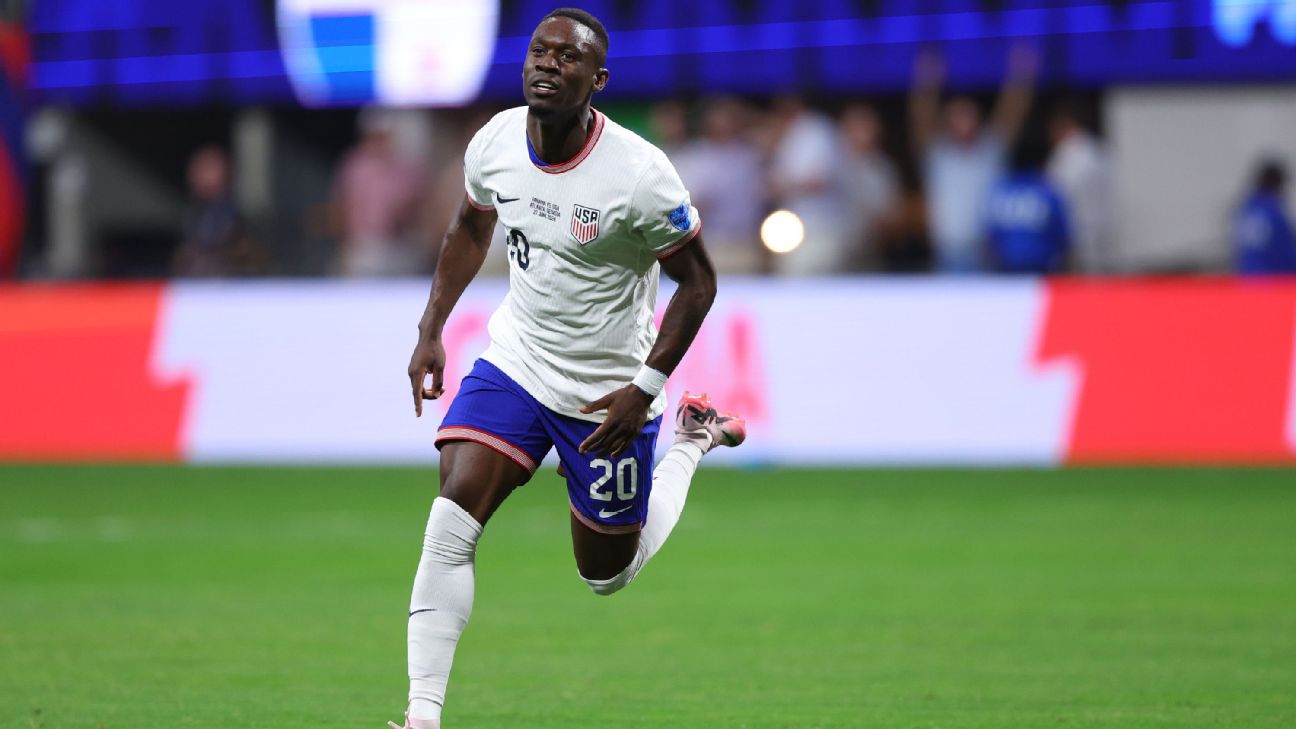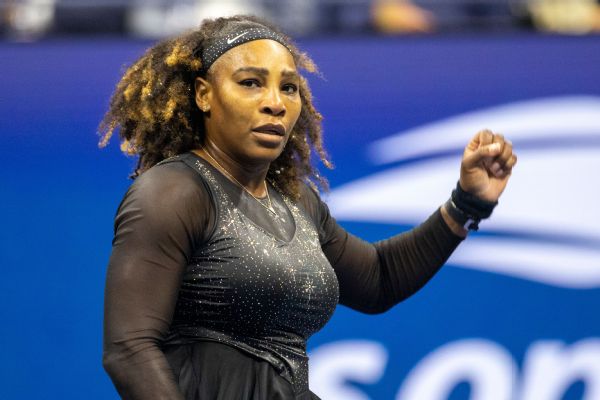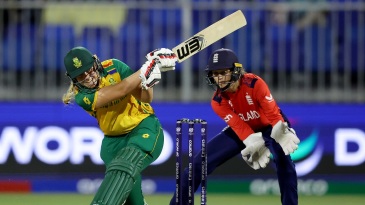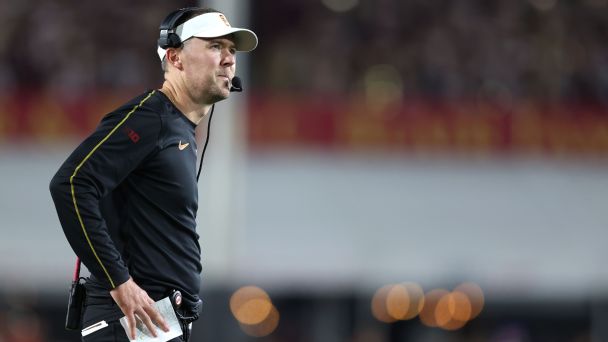![United States head coach Mauricio Pochettino gives instructions during the first half against Mexico [1296x729]](https://a.espncdn.com/photo/2024/1016/r1401275_1296x729_16-9.jpg)
Report USMNT s Balogun shoulder out 2 months
This was supposed to be the dawn of the new era.
The bad vibes of the Gregg Berhalter days were finally gone. And U.S. Soccer finally had its first truly world-class manager in former Chelsea, Paris Saint-Germain and Tottenham boss Mauricio Pochettino.
We'd get to see the U.S. play a coherent tactical style. The lineup choices would all make sense. And the USMNT would start consistently dominating the teams it's supposed to beat and occasionally winning games it had never won before ... right?
Not quite. The first two matches of the Pochettino era were, well, let's call them "underwhelming." There was a grind-it-out 2-0 win at home against Panama, followed by an almost-literally-never-had-a-shot 2-0 loss to Mexico.
Of course, these are just friendlies. These two matches will have almost zero bearing on what actually matters: what happens at the 2026 World Cup. The team's primary objective from these games wasn't to win. After the Mexico match, Pochettino called it a perfect opportunity "to learn."
So, what did we learn from his two games in charge?
1. Pochettino continues to flout tactical and positional designationsI've seen many people describe the base of the USMNT's formation in Pochettino's first two matches as a "back four." In fact, before the game against Mexico, the U.S. Soccer website even claimed: "Following the 2-0 shutout of Panama on Saturday, the backline of Joe Scally, Mark McKenzie, Tim Ream and Antonee Robinson work together for the second time tonight."
This was before McKenzie got hurt during warmups, but he was replaced by fellow center-back Miles Robinson, and the TNT announcers referred to what they were seeing as a back four during the first half.
Now, there were four defenders on the field. And those players do normally occupy the traditional back-four roles: two full-backs and two center-backs. But this was not a back four, in or out of possession. There were three center-backs -- Robinson/McKenzie, Ream, and Scally -- and then two wing-backs: Robinson and Yunus Musah.
While the Robinson-Scally full-back pairing, in theory, would fit the trend we've seen across Europe -- one conservative full-back who pinches in to form a back three in possession; one attacking full-back who pushes high -- this isn't what happened in practice. Both Musah and Robinson stayed wide, both on and off the ball. These were Musah's and Robinson's combined touches across both matches
At Chelsea last season, Pochettino's choices similarly confused those who talk about tactics on TV or write the code that presents formations on websites across the internet. He would frequently play full-back Ben Chilwell as a winger, in front of a back four, but because there were technically five defenders on the field, the formation would frequently get confused as a back three or back five.
Why does any of this matter? It doesn't really -- call it whatever you want; it won't affect what actually happens on the field. But insofar as we can read anything into what Pochettino is trying to do with this USMNT team, we can at least look at where he's asking his players to position themselves. Scally is usually a full-back, but he didn't push forward; Musah is a midfielder normally, but he didn't pinch into the middle. This is a choice, and it's quite different from what Berhalter was doing.
If you squint hard enough, it looks like Pochettino tried to get the U.S. to ride the latest tactical trend over in Europe. Driven by Manchester City, most big teams try to possess the ball in a three-box-three shape -- a backline of three, then two at the base of a midfield, two atop the midfield, and then three in the front line.
It's so popular because it's robust against counterattacks (a three-man backline shielded by two midfielders), it can dominate possession (four midfielders overwhelm the center), and it still provides plenty of width and threat in the attacking third (two wingers, the striker, and the two attacking midfielders pushing into the half-spaces).
Most teams access this shape by having a full-back or even a center-back slide into the midfield when they have the ball. This allows them to defend with a normal back four, plus three midfielders, plus two wingers and a striker, so they're not overwhelmed in any area of the field. There are two players on both wings and still three midfielders clogging the middle.
Now, the rotations necessary for this to happen smoothly require a lot of practice -- the kind of practice that national teams don't get. So, maybe Pochettino opted for a formation where his team was constantly -- again, vaguely -- in this three-box-three shape. Aidan Morris and Gianluca Busio occupied the base of the midfield. Against Panama, Christian Pulisic and Brenden Aaronson played more as attacking midfielders than wingers. And then, as we saw on the opening goal in that match, the wing-backs are able to push up super-high to provide the width in the final third:
I don't know if Pochettino has a long-term plan to try to develop the team within this structure. Or if he felt that it was the easiest way to quickly get the team up to speed, playing a nascent version of whatever he ultimately envisions them looking like.
Either way, it's not quite working yet.
2. Where's the press?For a number of reasons, it's harder to press aggressively out of these three-box-three setups. Manchester City, especially, have been pressing less and less as they've adopted this approach. It's even harder to do it within the in-and-out-of-possession 3-4-3 the U.S. was playing. The numbers don't quite match up in the right way, and without the full-backs pushing really high, the attacking midfielders have to push out wide to close down the opposition full-backs, and then holding midfielders get overwhelmed in the middle.
While there were a couple of chances triggered by pressing against Panama, Pochettino's trademark press only flickered into existence a couple times across both matches. The numbers were especially stark against Panama: 19.0 passes allowed per defensive action (PPDA); 84.2% opposition pass completion. That's the fifth-highest PPDA and 10th-highest pass-completion percentage this team has allowed in any match since the start of 2022. The Mexico numbers weren't as extreme, but El Tri went up early and the game got weird in the second half.
Despite that, I actually think the U.S. team defended pretty well in both matches. Or maybe the better way to put it is that they defended each individual chance well, but they gave up too many chances. They were outshot in both matches: Panama took 13; Mexico 15. But those were mainly all low-probability chances; the former averaged 0.07 expected goals (xG) per shot, the latter 0.05 xG/shot.
To be clear, I don't think the plan was to press aggressively. When a press doesn't work, the team still presses but it just gets ripped apart and gives up lots of fast breaks. The U.S. didn't try to press, but it also didn't really try to exploit the space it created in the opposition half by defending deep in either game.
Maybe it's the start of a grand plan for the U.S. to get used to playing in a way that will suit matches when it is the less talented team. Or maybe it's just some experimentation over two matches no one is going to ever think about again in a couple weeks.
3. Your world-class coach can't sign world-class playersThe estimated market value of the roster of Chelsea, Pochettino's previous employer, is €954.2 million, per the site Transfermarkt. Before that, his front three at PSG featured three unheralded workmanlike prospects named Neymar, Kylian Mbappé, and Lionel Messi. And before that, at Tottenham, his best player was Harry Kane, who Bayern Munich paid a fee of €100m to sign last summer.
Per these same Transfermarkt valuations, the U.S. squad Pochettino called in for these matches was worth €256.8m, which ranks 24th among all national teams right now -- between Ukraine and Ivory Coast. Not only that, the roster's best player, Pulisic, only played against Panama, and its second-best player, Weston McKennie, didn't play at all.
Oh, and Monaco's Folarin Balogun, PSV's Sergiño Dest, Real Betis' Johnny Cardoso, Bournemouth's Tyler Adams, Juventus' Timothy Weah, Borussia Dortmund's Giovanni Reyna, and Crystal Palace's Chris Richards all missed this window with injuries.
Given the roster of players for both matches, you'd expect the U.S. to beat Panama at home and lose to Mexico on the road -- which is exactly what happened. No coach -- not Pep Guardiola, not Jurgen Klopp -- is good enough to take the players Pochettino had on Tuesday and go toe-to-toe with Mexico on the road.
I mean, sure, Pochettino could have rolled out some super-conservative underdog tactics and tried to nab a result, but that's a waste of a friendly. Instead, it seemed like he tried to get his back-ups and third-stringers playing like he'd want his starters to.
Against Mexico, there just weren't any shots on the field. Other than Malik Tillman, who struggled, there really weren't any players whose main skills are creating shots for others or for themselves. The team didn't attempt a shot in the first half -- something that never happened during the Berhalter era. The end result looked like this:
If you plug all of the theoretical first-choice players into this setup, it starts to make more sense. Reyna and Pulisic behind Balogun should produce plenty of shots. Then you've got either Adams or Cardoso with McKennie in the midfield -- a nice balance of a holder and a runner. Robinson and Dest would work just fine in the wing-back roles, and maybe you could even get silly and try having Dest pinch into the midfield to aid buildup play. Weah, too, has played primarily as a wing-back in his two seasons with Juventus.
To have any real chance of making a run to the World Cup quarterfinals or beyond in 2026, Pochettino will need most, if not all, of those names at his disposal. You knew that already, but just in case you had visions of some kind of tactical wizardry papering over all of the holes in the American talent pool, these two games were a low-stakes reminder that players are the ones who play the games.







